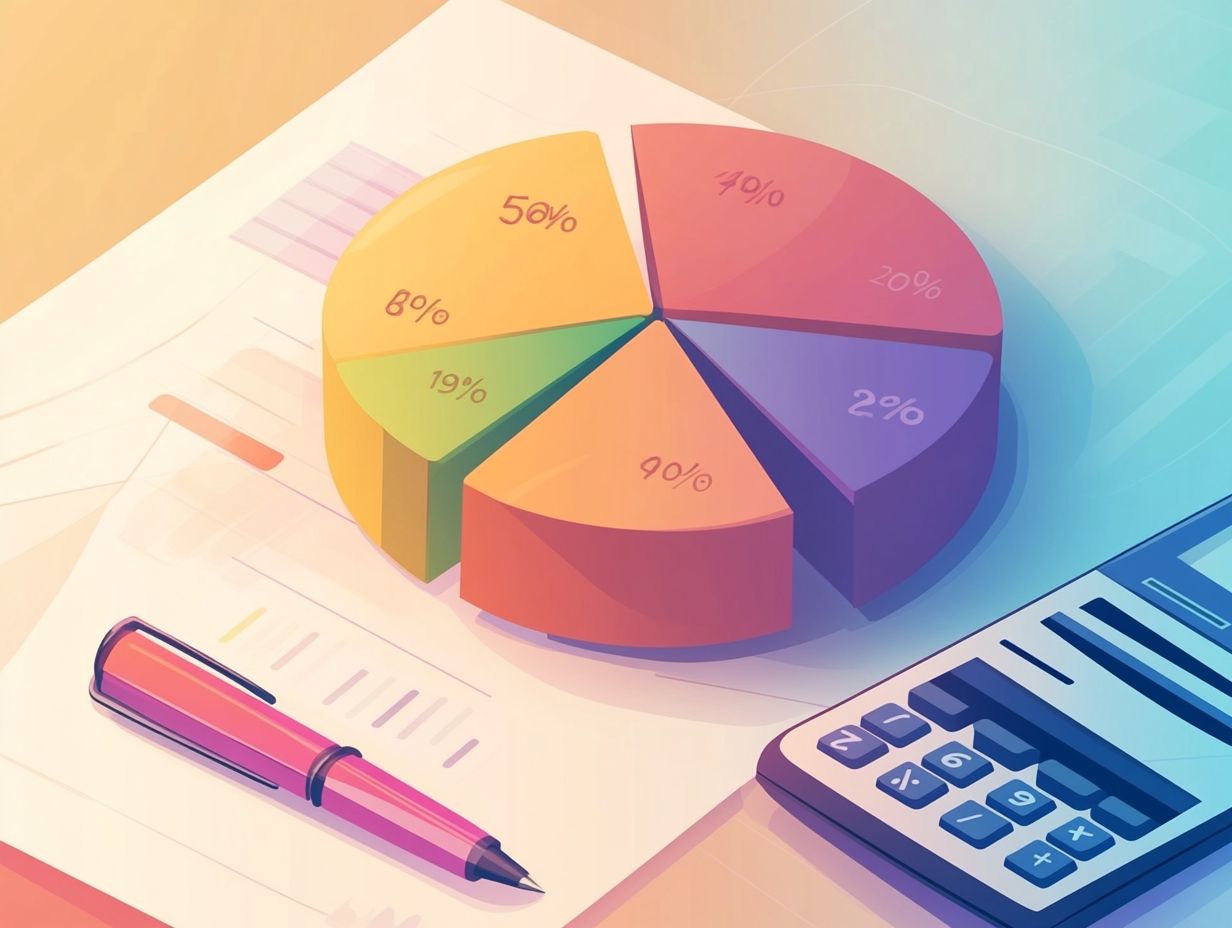What Is Credit Utilization?
Understanding credit utilization is essential for anyone striving to maintain a healthy credit score. This article delves into the concept, clearly defining its importance and relevance to your financial journey.
You ll discover how credit utilization impacts your credit score, along with the various factors that come into play.
Learn how to calculate your credit utilization ratio, identify the ideal percentage to aim for, and explore effective strategies to enhance your utilization.
You ll also find tips to help you monitor and manage your ratio effectively. Ready to boost your credit score? Let s dive in!
Contents
Key Takeaways:

- Credit utilization is the amount of credit you are using compared to the total credit available to you.
- High credit utilization can negatively impact your credit score, so it’s important to keep it low.
- To calculate your credit utilization ratio, divide your credit card balances by your credit limit and multiply by 100.
Understanding Credit Utilization
Credit utilization is an essential financial metric that you should be aware of; it reflects the ratio of your current credit card balances to your total available credit limits.
This ratio plays a significant role in shaping your credit score. Credit bureaus such as Experian, Equifax, and TransUnion closely monitor this figure, as it is a crucial component in calculating your FICO score or VantageScore.
By grasping the intricacies of credit utilization, you can take control of your credit accounts and cultivate a robust credit history an essential aspect of responsible financial management.
How Credit Utilization Impacts Credit Score
Credit utilization significantly influences your credit score, and a high utilization ratio can adversely affect your overall credit health.
Credit scoring models, particularly FICO and VantageScore, take your utilization percentage into account when evaluating how trustworthy you are when it comes to using credit. Therefore, it s crucial for you to monitor your available credit and outstanding balances diligently.
Factors That Affect Credit Score
Several factors influence your credit score, with the credit utilization ratio standing out as one of the most significant. Other important components include credit inquiries, your overall credit history, and how you manage your debt accounts.
Credit utilization plays a crucial role in determining your creditworthiness. To achieve optimal scores, it’s essential to keep this ratio below 30%.
Be mindful of hard credit inquiries, as they occur when lenders check your credit before approving loans. These inquiries can temporarily lower your score and may signal potential risk if they happen too frequently.
Maintaining a diverse mix of debt accounts, such as credit cards and installment loans, showcases your responsible credit management. Each of these elements intertwines to create a comprehensive picture of your financial behavior, highlighting the importance of a well-rounded credit history.
Calculating Credit Utilization Ratio

Calculating your credit utilization ratio is a simple yet essential task that provides valuable insight into your credit health. You achieve this by dividing your total credit card balances by your total available credit limits.
To embark on this process, gather the balances of your credit accounts along with your total credit limit. Fortunately, there are online calculators specifically designed to assist you in this endeavor, making it effortless to track and assess your credit situation.
Formula and Examples
Calculating your credit utilization is straightforward. Simply divide your total balance across all credit accounts by your total credit limit, and multiply by 100 to express it as a percentage.
For example, if your total balance is $2,500 and your credit limit is $10,000, your utilization stands at 25%.
This percentage is a vital indicator of your credit health, showing how much of your available credit you’re using. If your total balance drops to $1,500 while your credit limit remains the same, your utilization ratio falls to 15%.
Conversely, if you increase your credit limit to $15,000 while keeping the $2,500 balance, your utilization improves to approximately 16.67%.
These adjustments illustrate how raising your credit limit can significantly influence your utilization, ideally lowering it. Such a favorable change is viewed positively by lenders and can enhance your credit score over time.
Ideal Credit Utilization Ratio
Maintaining an optimal credit utilization ratio is crucial for a healthy credit score. Financial experts suggest aiming for a target of 30% or lower. This is considered ideal for your credit health.
Keeping your utilization low not only boosts your credit score but also signals to lenders that you manage your credit responsibly, greatly reducing the risks of high balances.
Recommended Percentage and Why
The advisable credit utilization percentage of 30% or lower is based on research linking this level to higher credit scores and improved financial behavior among consumers. Staying within this threshold can significantly reduce the impact on your credit score, showcasing responsible credit habits.
Studies show that individuals maintaining their credit utilization at or below this level often enjoy credit scores exceeding 700 points. According to FICO data, those with rates below 30% typically align with lower risk profiles, opening the door to better loan terms and interest rates.
Effectively managing your utilization establishes consistency in your financial behavior and nurtures a disciplined approach to borrowing and spending. This can boost your financial stability and pave the way for future credit opportunities.
Strategies for Improving Credit Utilization

Improving your credit utilization requires a proactive approach. Focus on reducing debt and possibly increasing your credit limits to enhance your overall credit health.
By applying responsible financial management practices, you can effectively lower your utilization rates and positively impact your credit score over time.
Effective Ways to Lower Credit Utilization
To lower your credit utilization effectively, consider a variety of strategies. Start by reducing your overall debt and managing your balance payments diligently. Closing unused credit cards can also help eliminate the temptation to overspend.
Prioritizing timely payments demonstrates financial responsibility, further enhancing your credit profile. Consolidating debt into manageable payments simplifies your finances and can lower the overall balances owed.
Take advantage of credit limit increases on your existing cards, as this can reduce your utilization ratio without adding to your debt. Regularly reviewing your credit reports ensures that all information is accurate and reflects responsible usage.
Maintaining older accounts plays a key role in boosting your credit longevity. Each of these techniques not only supports better credit management but also fosters a more secure financial future for you.
Monitoring and Managing Credit Utilization
Monitoring and managing your credit utilization is crucial for maintaining a robust credit profile. Regularly checking your credit reports keeps you informed about your credit habits and any potential issues that may arise.
By utilizing consumer protection tools and staying aware of credit inquiries, you gain valuable insights into your overall credit health, empowering you to make informed financial decisions.
Tips for Maintaining a Healthy Ratio
To maintain a healthy credit utilization ratio, consider adopting effective credit tracking practices and engaging in responsible financial management. Regularly review your credit limit and outstanding balances. This helps you avoid excessive debt and maintain a strong credit score.
Utilizing budgeting tools can help monitor your spending habits and identify areas for necessary adjustments. Setting alerts for due dates and payment reminders will help you dodge late fees, ultimately supporting your overall credit health. Aim to use only a portion of your available credit ideally keeping that utilization below 30% to positively influence your credit score.
Stay on top of your expenses! Regularly check your credit reports for any discrepancies to build a strong financial future.
Frequently Asked Questions

What Is Credit Utilization?
Credit utilization refers to the percentage of your available credit limit that you are currently using. It is an important factor in determining your credit score and overall financial health. Your credit limit is the maximum amount a lender allows you to borrow.
How is Credit Utilization Calculated?
To calculate your credit utilization, divide your total credit card balances by your total credit limit. For example, if you have a credit card with a $5,000 limit and a balance of $1,500, your credit utilization would be 30%.
What Is Considered a Good Credit Utilization Ratio?
A good credit utilization ratio is typically considered to be below 30%. This shows that you are responsibly using your available credit and not relying too heavily on credit cards.
Can High Credit Utilization Affect My Credit Score?
Yes, high credit utilization can negatively impact your credit score. Credit bureaus view high credit utilization as a sign of financial instability and may lower your credit score as a result.
How Can I Improve My Credit Utilization Ratio?
To improve your credit utilization ratio, you can either decrease your credit card balances or increase your credit limit. You can also consider paying off your balances in full each month to keep your credit utilization low.
Is Credit Utilization the Same as Credit Card Debt?
No, credit utilization and credit card debt are not the same. Credit utilization is a percentage that compares your credit card balances to your credit limit. Credit card debt refers to the actual amount of money you owe on your credit card.
Take action today to manage your credit utilization effectively. Consider checking your credit report and utilizing budgeting tools to improve your financial health!






